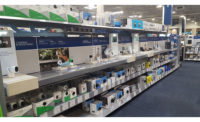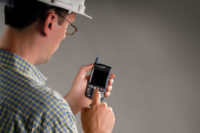

Until recently, “you had a lot of sites that were highly secure employee-wise, but visitors were just waved in,” notes Scott Howell, manager of worldwide marketing for Hirsch Electronics, a Santa Ana, Calif.-based security manufacturer.
Visitor management systems change that ironic reality by providing a mechanism for verifying a visitor’s identity, typically by allowing visitors to scan a business card or driver’s license. For organizations that previously used a receptionist or security guard to gather such information manually, self sign-in visitor systems can be a labor saver. The systems also enhance accountability — a capability that is increasingly important in an era when corporate governance concerns are top of mind. Many organizations are now required by law to keep records of who has been coming and going — and by enabling security personnel to generate reports by name or company, visitor management systems can simplify that responsibility immensely.
Mark Domenauer, director of global safety and security for software developer Adobe Systems of San Jose, Calif., has seen significant savings in time since a visitor management system was installed at several company locations. “Before we had boxes and boxes of old labels and non-disclosure agreements,” notes Domenauer. “Any time we had to do statistics on how often a certain vendor or person was here, it was a huge manual process.”

Self-service visitor management kiosks can allow a visitor to scan a business card or driver’s license and then visit a receptionist to pick up the visitor’s badge.
Serving Up the Basics
A number of companies offer self-service visitor management kiosks — GE Security, Boca Raton, Fla.; Honeywell, Syosset, N.Y.; LobbyGuard Solutions, Raleigh, N.C.; EasyLobby, Needham, Mass.; Stopware, San Jose, Calif.; and others. These systems typically include a business card or driver’s license scanner, which are used only to collect non-confidential information. The driver’s license number and a visitor’s home address are not collected. Additionally the visitor may be asked to fill in some additional fields such as the name of the person they are coming to visit. After the information has been gathered, a badge is printed. This typically shows the visitor’s name and may also include a photo, which may be scanned from the visitor’s license or taken with a camera built into the kiosk. Some kiosks also have built-in badge printers — although some organizations prefer to have the badge print out at a receptionist or guard station, where personnel can make sure that the scanned photo matches the one on the badge.Self-serve visitor management systems typically do not eliminate the need for a receptionist or security guard, as someone must be on hand for troubleshooting. But a self-serve system can minimize the number of personnel needed for busy organizations that would otherwise require multiple receptionists in a lobby. And if an organization has several buildings, it may be able to leave some lobbies unattended by providing a video or voice link to a receptionist in another lobby.
“Now companies can get by with a leaner staff,” notes Beth Thomas, senior product manager for Honeywell Credentials and Readers.

If an organization has an access control system for use by employees, a third option is to issue the visitor a badge that works with that system, but only for a limited time. If the visitor management system is fully integrated with the access control system so that the two databases can share information, the visitor’s information can be made available to the access control system. If the servers are not linked, the access control system can track the comings and going of a certain visitor badge number, but security personnel would have to consult the visitor management system to obtain the visitor’s identity.
Some of the larger security manufacturers — including Honeywell and GE — offer both visitor management systems and access control systems. When a systems integrator buys both systems from the same vendor, it’s usually fairly simple and straightforward to integrate the two systems. Manufacturers that offer only access control or only visitor management often form a partnership arrangement to integrate with a manufacturer of the other type of system. Hirsch Electronics, for example, offers access control systems that have built-in visitor management capability, but they are not self-serve; an employee must handle the task. For organizations that want self-serve capability, Hirsch has integrated its system with a self-serve kiosk from EasyLobby. If a systems integrator wants to use access control and visitor management from two different vendors that have not already integrated their products, however, custom software development is required.

Visitor management kiosks can help some businesses get by on leaner lobby staff while providing high security.
Benefits of Going Solo
Self-serve visitor management systems can provide a wide range of capabilities and benefits. Here are a few:-
Visitor screening — Some visitor management systems, including some from Stopware, can support watch lists of unwelcome visitors and alert personnel if one of them tries to gain entry — and the watch lists can be tailored to the type of organization. “At a school, you’d want to do a background check against sex offenders,” notes Paul Terschuren, Stopware vice president of sales and marketing.
- Managing non-disclosure agreements — Many companies require visitors to sign non-disclosure agreements. Traditionally this was handled manually by receptionists or security guards and the company had to store and track reams of paper agreements. Today’s self-serve visitor management systems can automate that process by displaying the agreement on a screen and requiring visitors to click on an icon to indicate that they agree to what they have read.

-
Safety procedure compliance — By logically connecting a video player with a visitor management kiosk, an organization can help ensure that visitors comply with safety procedures. An access control system can be set up so visitors cannot gain entry until they have first watched a safety video.
-
Visitor pre-registration — Some systems let employees pre-register an expected visitor through a link to a contact management system such as Microsoft Outlook so that all the visitor has to do upon arrival is pick up his or her badge. Visitors also may be able to pre-register themselves through a browser interface.
Pre-registration capability was particularly beneficial to a large client of Eastec, a systems integrator company based in Wall Township, N.J. that installs Honeywell’s visitor management systems. “The client was very interested because they could pre-register visitors and push that information to the receptionist,” notes Eastec president Fred Pierce. “If receptionists don’t have prior knowledge, they may have to hunt down the person the visitor has come to see, which hurts productivity.”
- Repeat visitors — Visitor management systems can be particularly appealing to people who visit a company frequently. “It creates a sense of convenience for people with busy lobbies, particularly for repeat visitors,” notes Carla Stewart, general manager of access control for GE. “For those who are already familiar with the system, it makes it very easy to gain entry.”

Some organizations have the badge print out at a reception desk or guard station.
-
Employee badge replacement — Depending on the system used, companies that have fully integrated their access control and visitor management systems may have an excellent way of accommodating employees who forget their access control credentials. San Jose, Calif.-based systems integrator RFI Communications and Security Systems uses a visitor management system from GE that lets administrators issue temporary badges for those employees.
As Greg Young, technical service manager for RFI explains, “Once the temporary card is active, the visitor management system pushes information to the access control system and picks up all of the person’s records. If you go back to the audit trail and one day an employee had a temporary badge, it shows up in the system as a temporary badge, but still includes the employee’s name.”
Young adds that the temporary badges have a more professional look than traditional temporary badges and can even include a photograph.
-
Vendor contract enforcement — Visitor management systems also can help enforce exclusive contracts that organizations such as Adobe Systems have with key vendors. As Domenauer explains, “If other companies are on campus trying to get that business, purchasing will know and can ask the person they were visiting, ‘Did you know we have a contract with ABC Company to provide service at a discount?’”
- Partitioning — Some visitor management systems support partitioning, which can be a useful feature for organizations with multiple locations. As John Campanola, product manager for GE explains, “If you have a facility in New York and another in New Jersey, for example, you can set the system up so that the administrator at each location only sees information for his own system.”

For organizations that want self-serve capability, Hirsch has integrated its system with a self-serve kiosk from EasyLobby.
Future Developments
As technology advances, visitor management systems are likely to become even more powerful in the future. One promising development is visitor credentials with built-in wireless communications capability, notes Ram Ramaprasad, director of product management for Zebra Technology Corp., a Vernon Hills, Ill.-based manufacturer of printers that are used with visitor management systems. “When you have that capability built in, if someone is in an area where they are not supposed to be, a reader can alert security,” he explains.One industry stakeholder also sees visitor management systems attracting the attention of the insurance industry. “Ultimately it may impact insurance premiums,” predicts Kevin Allen, president of LobbyGuard. “It adds an additional level of security just as security guards and video cameras do.”

Sidebar: Self-serve kiosks affirm Symantec’s high-security image
Symantec, a Cupertino, Calif.-based developer of security software for computer systems, installed a self-serve visitor management system from Stopware about three years ago at several of its corporate locations. The system is customized with Symantec’s brand on it and has a consistent look and feel from one location to another.As Curtis Given, global security manager for the Americas for Symantec explains, “We use it for visitor management tracking. We know who is in our facilities at all times, we get an accurate count of visitors and the system tracks our visitor confidentiality agreements.”
Visitors use a self-serve kiosk to register, then see the receptionist to get a visitor badge, which is automatically printed out by the system. In comparison with the previous paper-based system, Given says, “It keeps people from trying to scan our visitor book.”
The system is in keeping with Symantec’s high-security image, Given says, adding that the company is considering installing unattended visitor management locations in lower-traffic locations. The system would let visitors see and talk to a receptionist in another company location via a video screen.





